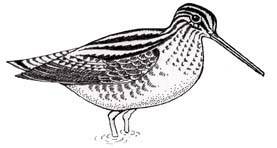

The common snipe breeds in the summer from Alaska to Newfoundland south to the mid-United States. It winters north from northern South America to British Columbia, the northern Gulf States and Virginia. It is also found in Europe, Northern Africa and Asia.
They are located by ponds, in marshes, wet meadows and bogs.
They are brownish tan with black stripes (bars) and a white chest and belly. They have a striped head with a long, pointed bill.
They hide in the tall grass. If they are threatened by a predator, they try to scare it off by bursting out from its hiding place and flying in a zig-zag pattern to escape.
They eat seeds and fruits.
Males are territorial and to attract a mate, they do a flying, diving display. Their feathers making a drumming sound as they dive. They make a nest in a clump of tall grass where the female lays about 4 eggs.
Kingdom: Animalia
Phylum: Chordata
Subphylum: Vertebrata
Class: Aves
Order: Charadriiformes
Family: Scolopacidae
Genus: Gallinago
Species: G. gallinago
When you research information you must cite the reference. Citing for websites is different from citing from books, magazines and periodicals. The style of citing shown here is from the MLA Style Citations (Modern Language Association).
When citing a WEBSITE the general format is as follows.
Author Last Name, First Name(s). "Title: Subtitle of Part of Web Page, if appropriate." Title: Subtitle: Section of Page if appropriate. Sponsoring/Publishing Agency, If Given. Additional significant descriptive information. Date of Electronic Publication or other Date, such as Last Updated. Day Month Year of access < URL >.
Amsel, Sheri. "Snipe (Common)" Exploring Nature Educational Resource ©2005-2024. December 13, 2024
< http://www.exploringnature.org/db/view/Snipe-Common >

